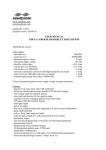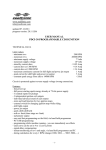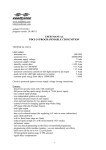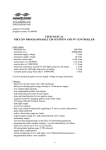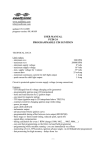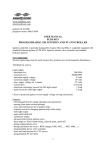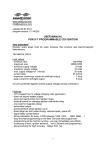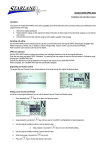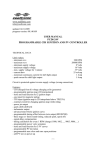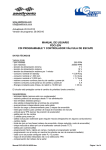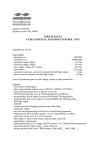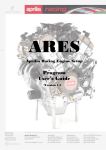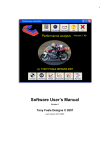Download user manual pdci-12 programmable cdi ignition
Transcript
www.zeeltronic.com [email protected] updated 29.06.2010 program version: 20.280610 USER MANUAL PDCI-12 PROGRAMMABLE CDI IGNITION TECHNICAL DATA Limit values: - minimum revs - maximum revs - minimum supply voltage - maximum supply voltage - max idle current draw - maximum continuous current for shift light and power jet output - peak current for shift light and power jet output - constant spark energy from idle to 13000 RPM 200 RPM 20000 RPM 9 Volts 18 Volts 60 mAmp 1 Amp 5 Amp >35mJ Circuit is protected against reverse supply voltage (wrong connection). Features: - one channel isolated input (pickup) - store and load function for two ignition curves - RAVE output (Aprilia RS125 exhaust valve) - TPS input (Throttle Position Sensor) - shift light output - power jet output - quick shift (shift kill) - soft rev limit (three stage rev limit) - external switch for changing ignition map while riding - tachometer output - ignition test (spark execution test without running engine) - easy and fast programming on the field, via hand held programmer and PC-USB - programming while machine running - you can immediately see effects - each curve can be set in 4 to 12 curve points - 3D interpolated ignition map, if TPS selected - signal delay compensation - instant monitoring of rev's and angle, via LCD(hand held programmer) - fast processing for high accuracy - delays from 1us - timing calculation for every 1 RPM change (1000, 1002, .. , 9805, 9806, ...) -1- Very important! Resistor spark plugs, or resistor spark plug caps must be used, because they produce less electromagnetic disturbances. For correct operation distance between pickup and rotor must be 0.3-0.4mm! 1. HOW TO ENTER MENU PDCI must be connected to power supply. Connect programmer to PDCI and wait few seconds for activation of programmer and then press enter. With pressing + or - you can move through menu and with pressing enter you can choose. You can exit menu with choosing Exit. 2. MENU ORGANISATION Load Ign. Curve Save Ign. Curve Set Ignition Curve RAVE open Advance Gear Shift Light Shift Kill Time Rev Limit Static Angle Compensation Power Jet TPS TPS close [0%] TPS open [100%] Remote SW Ignition Test Exit 3. - load previously saved ignition curve set (from #1 to #2) - save new ignition curve set (from #1 to #2) - ignition curve parameters - RAVE solenoid (Aprilia exhaust valve) - advance/retard whole ignition curve - shift light - shift kill time - rev limit - static angle (stator position) - signal delay compensation (from pickup to spark plug) - power jet - enable/disable Throttle Position Sensor - calibrating TPS close position (only if TPS enabled) - calibrating TPS open position (only if TPS enabled) - enable/disable external switch for changing ignition map - spark execution test without running engine LOAD IGN. CURVE Enter menu and move to Load Ign. Curve with pressing + or - and then press enter . Now you can select position number of previously saved ignition curve set, with pressing + or - and then press enter . 4. SAVE IGN. CURVE Enter menu and move to Save Ign. Curve with pressing + or - and then press enter . Now you can select position number to which you want to save your ignition curve set, with pressing + or - and then press enter . -2- 5. Change IGNITION CURVE (if TPS disabled) Enter menu and move to Set Ignition Curve with pressing + or - and then press enter . Now you are in submenu for setting ignition curve. Submenu organisation: Nr. of Points - number of ignition curve points (from 4 to 12) 1) - first ignition curve point 2) - second ignition curve point ... ... ... ... Exit Curve - exit submenu Important! To avoid wrong processing, don't make unreasonable curve course. Every time you make any changes to ignition curve, it is automatically saved to #0 position. Then you can save it to any other position number from #1 to #2. Curve Example with six curve points: -3- 5.1. Set IGNITION CURVE (if TPS enabled) Three ignition curves must be programmed for different TPS positions. PDCI does not only switch between ignition curves, but also calculate timing between programmed curves for all TPS positions above 33%. From 0% to 33% TPS is used only one ignition curve. Enter menu and move to Ignition Curve with pressing + or - and then press enter . Now you are in submenu for selecting ignition curve. Submenu organisation: Nr. of Points - number of ignition curve points (from 4 to 10) Curve 0-33% - ignition curve from 0 to 33% TPS Curve 66% - ignition curve for 66% TPS Curve 100% - ignition curve for 100% TPS Exit - exit submenu Important! To avoid wrong processing, don't make unreasonable curve course. Every time you make any changes to ignition curve, it is automatically saved to #0 position. Then you can save it to any other position number from #1 to #2. Curve Example: 5.2. Change NUMBER OF IGNITION CURVE POINTS Move to Nr. of Points with pressing + or - and then press enter . Now you can select number of ignition points, with pressing + or - and then press enter . -4- 5.3. Change PARAMETERS OF IGNITION CURVE POINT Move to point you want to change, with pressing + or - and then press enter . Now you can change rev point with pressing + or - (in 100 rpm steps) and then press enter . Now you can change advance angle with pressing + or - (in 0.1deg steps) and then press enter . 6. Set RAVE open Enter menu and move to RAVE open with pressing + or - and then press enter . Now you can change rev point with pressing + or - (in 100 rpm steps) and then press enter . 7. Set ADVANCE With this setting is possible to advance or retard whole ignition curve. When setting is positive then ignition curve is advanced and when setting is negative than ignition curve is retarded. With Advance 0.0deg, ignition curve is unchanged. Enter menu and move to Advance with pressing + or - and then press enter . Now you can set advance with pressing + or - (in 0.1deg steps) and then press enter . 8. Set GEAR SHIFT LIGHT Enter menu and move to Gear Shift Light with pressing + or - and then press enter . Now you can change rev point with pressing + or - (in 100 rpm steps) and then press enter . 9. Set SHIFT KILL TIME Enter menu and move to Shift Kill Time with pressing + or - and then press enter . Now you can change kill time with pressing + or - (in 10 ms steps) and then press enter . 10. Set REV LIMIT Enter menu and move to Rev Limit with pressing + or - and then press enter . Now you can change rev limit with pressing + or - (in 100 rpm steps) and then press enter . -5- 11. Set STATIC ANGLE Enter menu and move to Static Angle with pressing + or - and then press enter . Now you can set static angle with pressing + or - (in 0.1deg steps) and then press enter . More information's about static angle you can find in section 19. 12. Set COMPENSATION It is compensation of signal delay from pickup to spark plugs. You can check this delay with stroboscope lamp. Without this compensation, ignition advance angle decreasing with rising revs. This compensation helps that advance angles in ignition curve are real (more accurate). How to check, if compensation is correct: First you must set flat ignition curve. Then measure with stroboscope lamp, if mark at flywheel moving when changing revs. If mark moving then you must change compensation delay. Change Compensation: Enter menu and move to Compensation with pressing + or - and then press enter . Now you can change compensation delay with pressing + or - and then press enter . 13. Set POWER JET parameters Enter menu and move to Power Jet with pressing + or - and then press enter . Now you are in submenu for selecting Power Jet parameters. Submenu organisation: Power Jet ON RPM Power Jet OFF RPM Power Jet ON TPS Exit - revs for activating power jet - revs for deactivating power jet - throttle position for activating power jet - exit submenu Example: Power jet ON (RPM) = 8000rpm Power jet OFF (RPM) = 10000rpm Power jet ON (TPS) = 90%TPS Power jet is switched on, when revs are above 8000rpm and throttle position above 90%TPS. Power jet is switched off, when revs are above 10000rpm or throttle position is below 90%TPS. -6- 13.1. Set POWER JET ON RPM Enter menu and move to Power Jet 1 ON RPM with pressing + or - and then press enter . Now you can change rev limit with pressing + or - (in 100 rpm steps) and then press enter . 13.2. Set POWER JET OFF RPM Enter menu and move to Power Jet OFF RPM with pressing + or - and then press enter . Now you can change rev limit with pressing + or - (in 100 rpm steps) and then press enter . 13.3. Set POWER JET ON TPS Enter menu and move to Power Jet ON TPS with pressing + or - and then press enter . Now you can change TPS position with pressing + or - (in 1%TPS steps) and then press enter . 14. Set TPS Enabling or disabling Throttle Position Sensor. Enter menu and move to TPS with pressing + or - and then press enter . Now you can enable or disable TPS with pressing + or - and then press enter . 15. Set TPS close [0%] (if TPS enabled) For correct operation, TPS close position must be calibrated! Enter menu and move to TPS close [0%] with pressing + or - and then press enter . Leave throttle at close position and confirm calibrating with pressing enter , or exit calibration with pressing - . Displayed number should be between 0 and 500. 16. Set TPS open [100%] (if TPS enabled) For correct operation, TPS open position must be calibrated! Enter menu and move to TPS open [100%] with pressing + or - and then press enter . Move throttle to maximum open position and confirm calibrating with pressing enter , or exit calibration with pressing -. Displayed number should be between 500 and 1010. -7- 17. Set REMOTE SW Enabling or disabling external switch for changing ignition curves while riding. Enter menu and move to Remote SW with pressing + or - and then press enter . Now you can enable or disable external switch with pressing + or - and then press enter . 18. IGNITION TEST Spark execution test without running engine. Spark can be optically checked, with removed spark plug connected to plug cup and to the ground. Enter menu and move to Ignition Test with pressing + or - . With pressing enter multiple spark will occur, for about 1s. 19. MECHANICAL SETTINGS (Static Angle) Static Angle is ignition advance angle, set with stator (generator). Measure this angle with dial gauge. This measured Static Angle is your maximum advance angle you can set with PDCI. Calculating mm to deg or vice versa: 20. MONITORING Connect programmer to PDCI and wait few seconds for activation of programmer. Fist information displayed on the programmer is software version. With programmer you can watch revs, calculated advance ignition angle, selected ignition curve, TPS position...depends on setting in the menu. Information! You can connect or disconnect PDCI unit from programmer any time you want, without any harm. It is not important, if motor running or not and if power supply is connected or not. Important! Do not use too much force when connecting or disconnecting programmer unit! -8-








